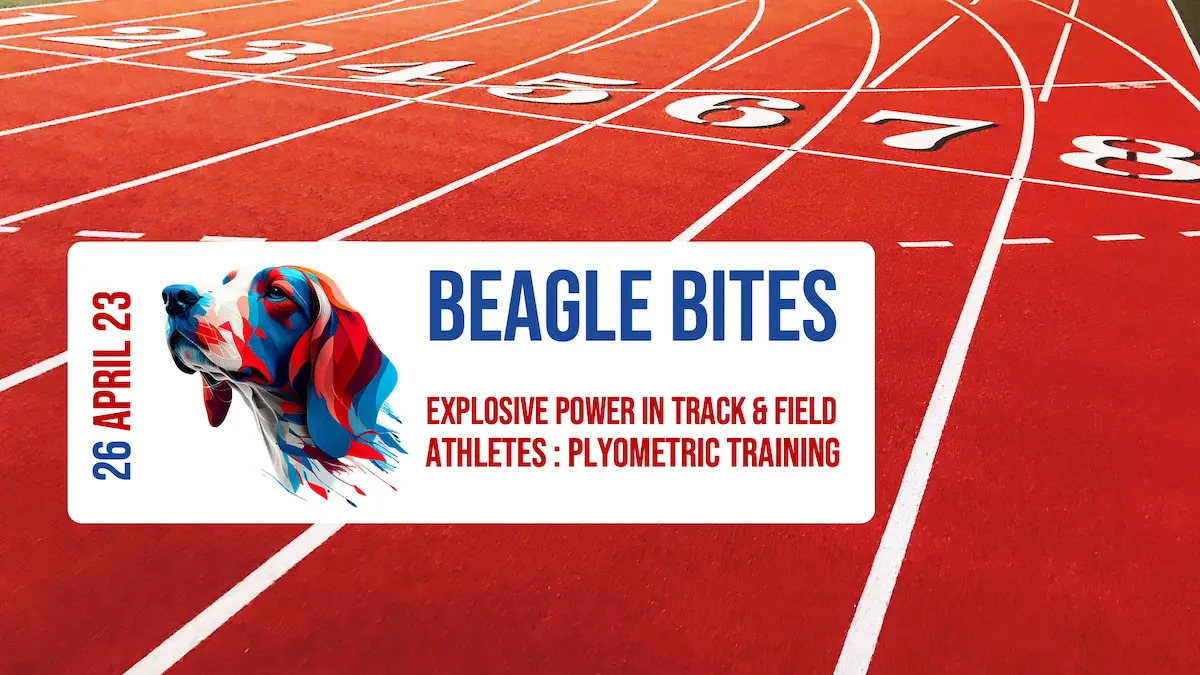Introduction to Plyometric Training
In the competitive world of track and field, athletes continually seek innovative and effective training methods to gain an edge over their opponents. Plyometric training, a technique that focuses on rapid, forceful movements, has emerged as a powerful tool for developing explosive power in athletes. This short Beagle Bites explores the mechanics, benefits and practical implementation of plyometric training for track and field athletes, drawing from academic research to provide a comprehensive and engaging analysis.
The Mechanics of Plyometric Training
Plyometric training, often referred to as “jump training”, is centred on the stretch-shortening cycle (SSC) of the muscle-tendon complex (MTC) (Cormie, McGuigan, & Newton, 2011). The SSC consists of three phases: the lengthening phase (or eccentric phase), the amortisation phase, a brief transition and the shortening phase (or concentric phase) (Ebben & Petushek, 2010). During the eccentric phase, the muscle-tendon unit is stretched and stores elastic energy. In the amortisation phase, the muscle prepares for the subsequent concentric contraction. Finally, the concentric phase involves the rapid release of the stored energy as the muscle contracts, generating a powerful movement (Markovic, 2007).
Plyometric exercises include various jumps, hops, bounds and throws that exploit the SSC to develop an athlete’s ability to generate force and power rapidly (Chu, 2018). These exercises are categorised based on their intensity, complexity and the specific muscles they target, allowing for tailored training programmes that cater to individual athletes and events (Bompa & Haff, 2009).
Benefits of Plyometric Training for Track and Field Athletes
Plyometric training has been extensively researched and shown to enhance numerous aspects of athletic performance. Some of the most notable benefits include:
- Increased Power Output: Plyometric exercises have been proven to improve an athlete’s power output, a key determinant of performance in explosive movements such as sprinting, jumping and throwing (Chelly et al., 2010). This is particularly relevant in track and field, where powerful, explosive actions are paramount.
- Enhanced Muscle Activation: Plyometric training leads to greater muscle activation, fostering more forceful contractions during rapid movements (Sáez de Villarreal, Requena, & Cronin, 2012). This increased activation translates to improved performance in events that demand rapid, high-intensity muscular contractions.
- Improved Reaction Time: Athletes who engage in plyometric training tend to exhibit faster reaction times, a vital component for success in competitive sports where every fraction of a second counts (Miller et al., 2006).
- Greater Agility: Plyometric exercises help develop an athlete’s agility, enabling them to change direction rapidly and maintain balance during intense movements (Chimera, Swanik, Swanik, & Straub, 2004). This can be particularly beneficial for events that involve sudden changes in direction or acceleration, such as hurdles or the long jump.
- Injury Prevention: Plyometric training can help athletes build stronger connective tissues and enhance joint stability, reducing the risk of injury during high-impact activities (Heidt et al., 2000).
Incorporating Plyometrics into an Athlete’s Regime
To maximise the benefits of plyometric training while minimising injury risk, coaches should consider the following guidelines when designing a training programme:
- Progressive Overload: Gradually increase the intensity and complexity of plyometric exercises to stimulate adaptation and prevent overtraining or injury (Chu, 2018).
- Periodisation: Integrate plyometric training into the athlete’s overall programme, ensuring it aligns with their specific goals and competition schedule (Bompa & Haff, 2009). This involves carefully planning the frequency, volume and intensity of plyometric workouts to optimise performance gains throughout the training cycle.
- Technique Focus: Emphasise proper technique and landing mechanics to promote safety and maximise performance gains (Chu, 2018). Proper execution of plyometric exercises is essential to avoid undue stress on joints and muscles, preventing injuries that could derail an athlete’s progress.
- Individualisation: Design plyometric programmes that cater to the individual needs and abilities of each athlete, taking into account their specific event, personal strengths and weaknesses (Bompa & Haff, 2009). This may involve selecting exercises that target specific muscle groups, address biomechanical imbalances, or complement the athlete’s existing training routine.
- Recovery and Regeneration: Ensure athletes have adequate recovery time between plyometric sessions to allow for adaptation and minimise the risk of overtraining or injury (Heidt et al., 2000). This may include incorporating active recovery methods, such as foam rolling or dynamic stretching, to promote tissue repair and maintain flexibility.
- Integration with Strength Training: Combine plyometric training with strength training to maximise the development of explosive power (Chelly et al., 2010). Research has shown that incorporating both modalities can lead to synergistic improvements in power output, agility and overall athletic performance.
With careful planning, attention to technique and a commitment to individualisation, plyometric training can be a powerful tool in the arsenal of track and field athletes and coaches alike.
Case Studies: Plyometrics Training in Action
To further illustrate the benefits and implementation of plyometric training for track and field athletes, here are two case studies that highlight its effectiveness in practice:
Case Study 1: Sprinters
A study by Maulder and Cronin (2005) examined the effects of a 6-week plyometric training programme on sprint performance in competitive sprinters. The athletes were divided into two groups: one group underwent a plyometric programme, while the other continued with their regular training. The plyometric group performed exercises such as bounding, double-leg hops and single-leg jumps, progressing in intensity and complexity throughout the programme.
After six weeks, the plyometric group exhibited significant improvements in 0-10m and 0-30m sprint times, while the control group showed no significant changes. This study demonstrates the effectiveness of plyometric training for enhancing sprint performance, particularly in the initial acceleration phase, which is critical for success in track and field events.
Case Study 2: Jumpers
A study by Adams, O’Shea, O’Shea and Climstein (1992) investigated the effects of plyometric training on the performance of collegiate long jumpers. The athletes were divided into a plyometric group and a control group, with the plyometric group participating in a 12-week programme that included depth jumps, single-leg hops and hurdle jumps.
Following the intervention, the plyometric group exhibited a significant increase in long jump distance compared to the control group. Additionally, the plyometric group demonstrated improvements in vertical jump height, an important indicator of explosive power. This study highlights the potential benefits of plyometric training for enhancing jumping performance in track and field athletes.
Case Study 3: Throwers
Plyometric training has also been shown to enhance throwing performance in track and field athletes. A study by De Villarreal, Kellis, Kraemer and Izquierdo (2009) examined the effects of a 12-week combined strength and plyometric training programme on javelin throw performance. The participants were divided into two groups: one underwent a combined strength and plyometric training programme, while the other group focused solely on strength training.
At the conclusion of the 12-week intervention, the combined training group demonstrated significant improvements in javelin throw performance compared to the strength-only group. Additionally, the combined training group exhibited greater increases in maximal strength and power output. This study underscores the importance of incorporating plyometric training alongside traditional strength training to optimise performance in throwing events.
Case Study 4: Hurdles
In hurdle events, athletes must exhibit both speed and explosive power to clear the barriers efficiently. A study by Badillo and Ayestarán (2000) investigated the effects of a 10-week combined plyometric and sprint training programme on hurdle performance in elite athletes. The participants were divided into two groups: one underwent the combined training programme, while the other group continued with their regular training.
Following the intervention, the combined training group demonstrated significant improvements in 60m hurdle performance compared to the control group. This study highlights the potential benefits of integrating plyometric training with traditional sprint training to enhance hurdle performance, where explosive power and speed are critical factors for success.
Conclusion
The case studies presented above demonstrate the versatility and effectiveness of plyometric training for various track and field events. Incorporating plyometric exercises into a well-rounded training programme allows coaches to help athletes develop explosive power, speed and agility, leading to improved performance across a range of disciplines.
As with any training modality, the key to success lies in us as coaches tailoring the programme to our individual athlete’s needs and goals. This includes selecting appropriate exercises, managing training volume and intensity and ensuring adequate recovery and regeneration. With careful planning and execution, plyometric training can be a valuable addition to the training toolkit of track and field athletes and coaches alike.
If you want to discuss this with a coach, please feel free to catch up with us at the track or contact us here.



